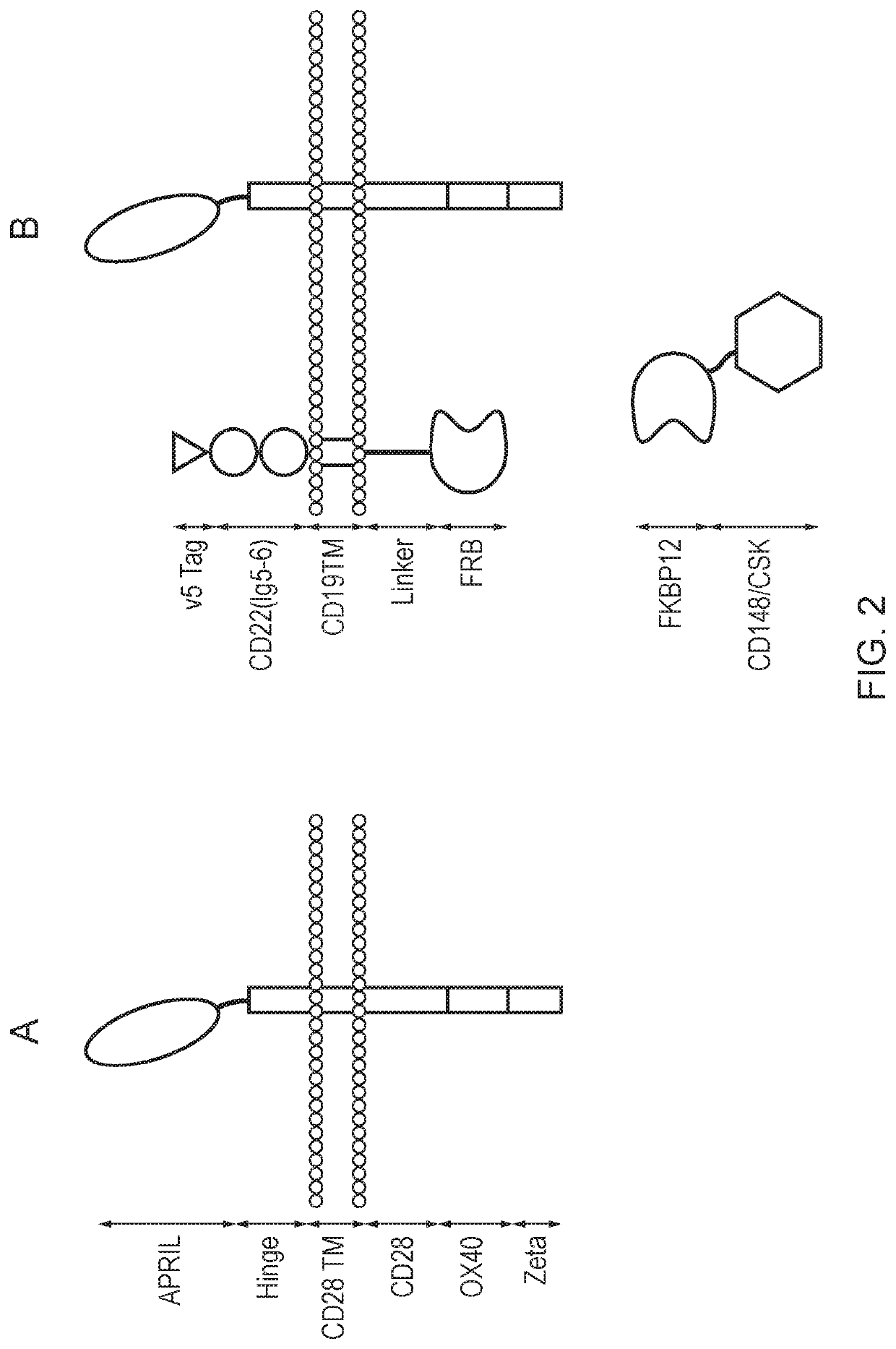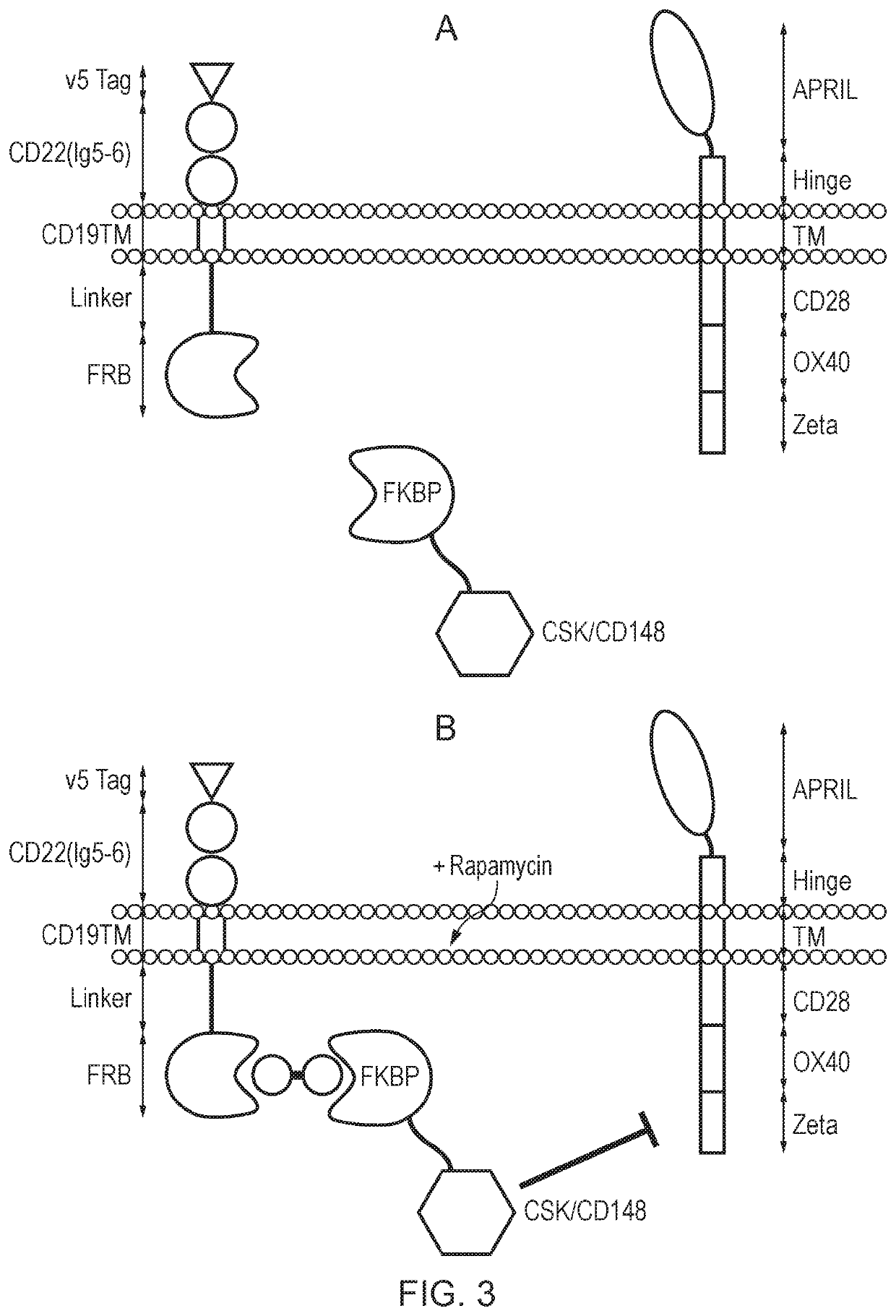A cell comprising a chimeric antigen receptor (CAR)
a cell and receptor technology, applied in the field of cells which contain chimeric antigen receptors, can solve the problems of difficult and quite often impossible to select and expand large numbers of t-cells specific for most cancer antigens, macrophage activation syndrome (mas), and “on-target off-tumour
- Summary
- Abstract
- Description
- Claims
- Application Information
AI Technical Summary
Benefits of technology
Problems solved by technology
Method used
Image
Examples
example 1
lity of a Rapa-Off Dampening System
[0463]A tricistronic construct is expressed as a single transcript having the structure:
[0464]SFGm R.V5_tag-CD22(2Ig)-CD19tm-RL-FRB-2A-FKBP12-L-CD148endo-2A-CAR
[0465]This self-cleaves at the 2A sites to a FKBP12-containing signal dampening component, a membrane tethering component comprising a transmembrane domain and an intracellular FRB domain, and an anti-CD19 second generation CAR.
[0466]The construct is expressed in BW5 cells. SupT1 cells (which are CD19 negative), are engineered to be CD19 positive giving target negative and positive cell lines which are as similar as possible. Primary human T-cells from 3 donors are transduced with two CAR constructs: (I) “Classical” anti-CD19 CAR; (ii) the tri-cistronic “dampenable” CD19 CAR system described above. Non-transduced T-cells and T-cells transduced with the different CAR constructs are challenged 1:1 with either SupT1 cells or SupT1.CD19 cells in the presence of different concentrations of rapamy...
example 2
lity of a Tet-ON Dampening System
[0469]A tricistronic construct is expressed as a single transcript having the structure:
[0470]SFG.TIP-L(16aa)-CD148endo-2A-V5-tag-CD22(2Ig)-CD19tm-RL-TetRB-2A-CAR
[0471]This self-cleaves at the 2A sites to a TiP-containing signal dampening component, a membrane tethering component comprising a transmembrane domain and an intracellular TetRB domain, and an anti-CD19 second generation CAR.
[0472]The construct is expressed in BW5 cells which are then challenged with wild-type SupT1 cells or SupT1 cells engineered to express CD19, in the presence or absence of tetracycline using the methodology described in Example 1.
[0473]As illustrated in FIGS. 5 and 6, in a “Tet-ON” dampening system in the presence of tetracycline, the signal dampening component diffuses freely in the cytoplasm, and CAR-mediated signalling can occur. In the absence of tetracycline, the signal dampening component dimerises with the membrane tethering component, bringing CD148 into proxim...
example 3
lity of a Rapa-Off Damning System with an Anti-BCMA CAR
[0474]A tricistronic construct was expressed as a single transcript having the structure:
[0475]SFGmR.V5_tag-CD22(2Ig)-TM-FRB-2A-FKBP12-CD148endo-2A-CAR
[0476]This self-cleaves at the 2A sites to a FKBP12-containing signal dampening component, a membrane tethering component comprising a transmembrane domain and an intracellular FRB domain, and an anti-BCMA third generation CAR having an antigen binding site based on a proliferation-inducing ligand (APRIL), the natural ligand for BCMA.
[0477]The construct was expressed in BW5 cells. SKOV3 cells, were engineered to be BCMA positive for use as target cells. Primary human T-cells from 2 donors were transduced with two CAR constructs: (i) “Classical” anti-BCMA CAR; (ii) the tri-cistronic “dampenable” BCMA CAR system described above, Non-transduced T-cells and T-cells transduced with the different CAR constructs were challenged 8:1 with SKOV3_BCMA cells in the presence of different conce...
PUM
| Property | Measurement | Unit |
|---|---|---|
| molecular mass | aaaaa | aaaaa |
| nucleic acid | aaaaa | aaaaa |
| concentrations | aaaaa | aaaaa |
Abstract
Description
Claims
Application Information
 Login to View More
Login to View More - R&D
- Intellectual Property
- Life Sciences
- Materials
- Tech Scout
- Unparalleled Data Quality
- Higher Quality Content
- 60% Fewer Hallucinations
Browse by: Latest US Patents, China's latest patents, Technical Efficacy Thesaurus, Application Domain, Technology Topic, Popular Technical Reports.
© 2025 PatSnap. All rights reserved.Legal|Privacy policy|Modern Slavery Act Transparency Statement|Sitemap|About US| Contact US: help@patsnap.com



